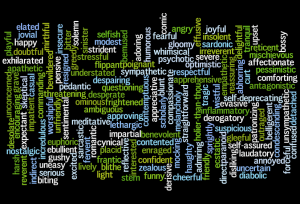Writing Instruction: Tone and Mood
When I was a teacher, it was difficult to get students to understand the difference between tone and mood. It’s understandable: tone and diction are what create mood, so without tone, mood doesn’t even exist. Diction, of course, is the writer’s word choice, while tone is defined by most dictionaries as “the manner in which a writer approaches the subject at hand.” Mood, then, is the feeling evoked in the reader based on the author’s choice of words and his/her tone. It’s a cause and effect relationship. Still, though, these definitions in and of themselves fall short of having any real meaning to students, which is why, when a splendid example of tone and mood comes along, it’s a great opportunity to show instead of tell.
The other day, syndicated columnist Jae-Ha Kim produced a most instructive piece of writing for illuminating tone and mood. If you want a wonderful lesson for your writing class, have them read Jae’s blog post called, “JiSun: Do You Remember My Sister?” While most textbook examples of tone are merely “sad” or “happy,” Jae’s tone here could best be defined as confrontational or angry–probably a lot more interesting to study. Ask your students how she accomplishes that tone. Have them notice how beginning the piece with a direct address immediately points a finger in the offender’s face. Ask them how that beginning serves the piece differently than if she’d begun, “Once there was a girl who was mean to my sister.” Have them notice the series of one-sentence paragraphs with parallel construction, each beginning with the same word, “maybe.” Ask them to sum up the message to JiSun in one or two sentences. (My take? “My sister’s over it, but my mom and I aren’t. Watch your back.”) What you’re teaching them, then, isn’t just a fuzzy definition of tone, but rather how tone is constructed by the choices the writer makes.
Ask them how they feel after reading the piece. My guess is that they will feel unsettled. And why? Because the writer’s control of tone CAUSED that reaction. Tone CAUSES mood.
Finally, for a fun and educational writing exercise, ask students to write a reply from JiSun’s point of view. After all these years, is she defiant or remorseful? Their use of tone will make it clear who JiSun grew up to be.




